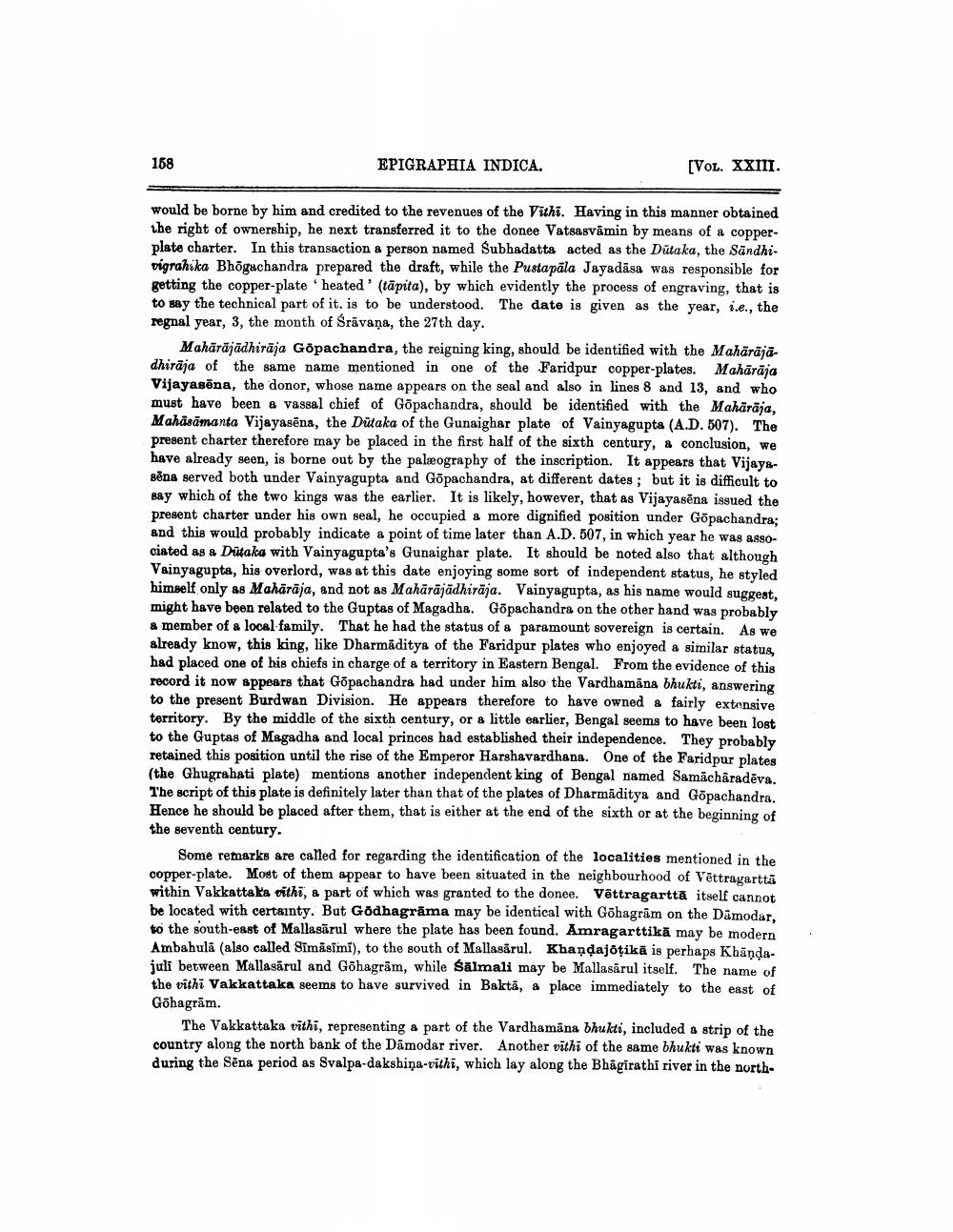________________
168
EPIGRAPHIA INDICA.
[VOL. XXIII.
would be borne by him and credited to the revenues of the Vithi. Having in this manner obtained the right of ownership, he next transferred it to the donee Vatsasvāmin by means of a copperplate charter. In this transaction a person named Subhadatta acted as the Dütaka, the Sāndhivigrahika Bhögachandra prepared the draft, while the Pustapāla Jayadāsa was responsible for getting the copper-plate heated' (tāpita), by which evidently the process of engraving, that is to say the technical part of it, is to be understood. The date is given as the year, i.e., the regnal year, 3, the month of Śrāvana, the 27th day.
Mahārājādhiraja Gopachandra, the reigning king, should be identified with the Mahārājadhiraja of the same name mentioned in one of the Faridpur copper-plates. Mahārāja Vijayasēna, the donor, whose name appears on the seal and also in lines 8 and 13, and who must have been a vassal chief of Göpachandra, should be identified with the Mahārāja, Mahāsāmanta Vijayasēna, the Dutaka of the Gunaighar plate of Vainyagupta (A.D. 507). The present charter therefore may be placed in the first half of the sixth century, a conclusion, we have already seen, is borne out by the palæography of the inscription. It appears that VijayaBēns served both under Vainyagupta and Gopachandra, at different dates ; but it is difficult to say which of the two kings was the earlier. It is likely, however, that as Vijayasēna issued the present charter under his own seal, he occupied a more dignified position under Gopachandra; and this would probably indicate a point of time later than A.D. 507, in which year he was associated as & Dritaka with Vainyagupta's Gunaighar plate. It should be noted also that although Vainyagupta, his overlord, was at this date enjoying some sort of independent status, he styled himself only as Mahārāja, and not as Mahārājādhirāja. Vainyagupta, as his name would suggest, might have been related to the Guptas of Magadha. Gopachandra on the other hand was probably a member of a local family. That he had the status of a paramount sovereign is certain. As we already know, this king, like Dharmāditya of the Faridpur plates who enjoyed a similar status, had placed one of his chiefs in charge of a territory in Eastern Bengal. From the evidence of this record it now appears that Gopachandra had under him also the Vardhamana bhukti, answering to the present Burdwan Division. He appears therefore to have owned & fairly extensive territory. By the middle of the sixth century, or a little earlier, Bengal seems to have been lost to the Guptas of Magadha and local princes had established their independence. They probably retained this position until the rise of the Emperor Harshavardhana. One of the Faridpur plates (the Ghugrahati plate) mentions another independent king of Bengal named Samācharadēva. The script of this plate is definitely later than that of the plates of Dharmāditya and Gopachandra. Hence he should be placed after them, that is either at the end of the sixth or at the beginning of the seventh century.
Some remarks are called for regarding the identification of the localities mentioned in the copper-plate. Most of them appear to have been situated in the neighbourhood of Vēttragartta within Vakkattaka vithi, a part of which was granted to the donee. Võttragartta itself cannot be located with certainty. But Gödhagrama may be identical with Gohagram on the Damodar, to the south-east of Mallasārul where the plate has been found. Amragarttikā may be modern Ambahula (also called Simāsimi), to the south of Mallasărul. Khandajöţikā is perhaps Khāndajuli between Mallasărul and Göhagram, while Sālmali may be Mallasārul itself. The name of the vithi Vakkattaka seems to have survived in Baktā, a place immediately to the east of Göhagram.
The Vakkattaka vithi, representing a part of the Vardhamana bhukti, included a strip of the country along the north bank of the Damodar river. Another vithi of the same bhukti was known during the Sēna period as Svalpa-dakshiņa-vithi, which lay along the Bhagirathi river in the north




